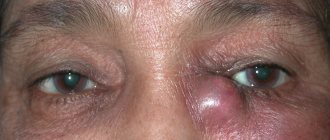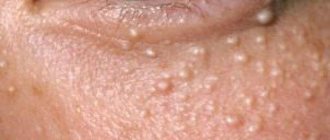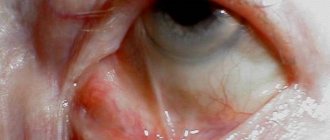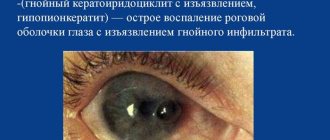What is blepharospasm
A healthy adult blinks at a rate of 10 to 20 times per minute. An increase in blink rate is known as blepharospasm. Blepharo (from Ancient Greek βλέφαρον) means eyelid. A spasm is an uncontrolled, involuntary contraction of muscles. Thus, blepharospasm is an abnormal focal dystonia that causes contraction or twitching of the orbicularis oculi muscle.
Blepharospasm begins gradually, with excessive blinking or irritation of the eyes. In the early stages, the symptom occurs only against a background of stress, fatigue and emotional exhaustion. The frequency of muscle contractions and spasms may increase, causing the eyelids to completely close.
Women suffer from blepharospasm three times more often than men. The symptom usually appears between the ages of 50 and 60 years. Its incidence is 5 cases per 100,000 people.
BLEPHAROSPASM
BLEPHAROSPASM
(
biepharospasmus
; Greek blepharon eyelid + spasmos spasm) - spasm of the circular muscle of the eyelids. Can be clonic or tonic. Clonic spasm of the orbicularis muscle manifests itself in involuntary rapid blinking. Tonic spasm of the orbicularis muscle leads to persistent spastic closure of the eyelids and can last for minutes, days, weeks. Tonic B. is more common.
Clonic blepharospasm (blepharotic), or blinking, is involuntary, lightning-fast in nature (see Tic).
Tonic blepharospasm can be symptomatic or essential.
Symptomatic tonic blepharospasm usually occurs as a result of reflex irritation of the branches of the trigeminal nerve in various diseases of the anterior part of the eye. B. occurs most persistently with scrofulous keratoconjunctivitis. B. significantly worsens the course of eye disease, often accompanied by significant swelling of the eyelids due to compression of the veins, as well as severe lacrimation, maceration of the skin, and cracks in the corners of the eyelids. With prolonged B., inversion or eversion of the eyelids may occur. There may be B. of healthy eyes due to reflex irritation of the branches of the trigeminal nerve in diseases of the oral cavity, paranasal sinuses, and nasopharynx. Tonic B. is observed with organic damage to the facial nerve and with a number of other diseases of the nervous system.
Essential blepharospasm is a functional disease caused by age-related changes in older people or psychogenic causes (hysteria, traumatic neurosis) in younger people. Hysterical B. is always bilateral and ch. arr. in young women suddenly, for no apparent reason. After a few hours, and sometimes after several weeks, the spasm also suddenly disappears. With this form of B., the so-called. pressure points at the exit site of the branches of the trigeminal nerve, when pressed on which the pain immediately stops.
With timely treatment of tonic blepharospasm, recovery usually occurs.
When treating B., it is necessary first of all to eliminate the underlying disease, especially the sources of irritation that reflexively cause it. A 0.5% solution of dicaine or a 2% solution of novocaine is instilled into the conjunctival sac several times a day. To relieve B.'s attack, press on the pressure points, if they are detected; injections of novocaine or morphine are indicated, in especially persistent cases - periorbital novocaine blockade or canthotomy. Treatment used for neuroses is also recommended.
See also Spasm.
Bibliography:
Barbsl I. E. Diseases of the eyelids, Multivolume. manual but eye Bol., ed. V. II. Arkhangelsk, vol. 2, book. 1, p. 32, 42, etc., M., 1960, bibliogr.; 3 o l o t n i c k i y I. N. About the treatment of contusiopic blepharospasms, Ophthalm. zhurn., X" 4, p. 46, 1946; Der Augeharzt, hrsg. v. K. Velhagcn, Bd 3, S. 41, Stuttgart, 1960.
A. I. Volokonenko.
Causes
Eye injury
Eye injury (mechanical, thermal or chemical) causes blepharospasm: this is a protective reaction of the eye to damage.
Inflammatory diseases of the anterior segment
Diseases such as blepharitis, conjunctivitis, keratitis, and iritis can cause symptoms.
Dry eye syndrome
Glaucoma
General pathologies
Some pathologies can also lead to the development of blepharospasm: multiple sclerosis, focal lesions, cerebral palsy and Tourette's syndrome.
Causes and symptoms
Blepharospasm begins gradually, with a single case of tic in the eye, and may not have any basis. But research by American scientists has convincingly proven that the idiopathic form in 70% of cases is inherited according to an autosomal dominant pattern of transmission of genetic diseases. This means that blepharospasm can be transmitted from father or mother to son or daughter if the offspring has at least one defective gene 9q34, 18q.
Secondary causes of the development of blepharospasm are organic pathologies:
- Cerebral ischemia. Lack of blood in brain tissue leads to hypoxia, which in turn disrupts metabolic processes in cells. The initial stages of the disease are manifested by spastic contractions of the eyes.
- Neurological diseases. Taking medications for the treatment of neurological pathologies (neuroleptics, antidepressants, psychotic drugs) in some cases gives a side effect in the form of blepharospasm.
- Mitochondropathy. A group of diseases in which the metabolic pathway is destroyed and the accumulation of energy in the mitochondria of cells becomes impossible. The pathological process is often complicated by involuntary twitching of the orbicularis oculi muscles.
- Pathological synkinesis. Involuntary additional movements occur against the background of paralysis of adjacent tissues. For example, narrowing of the palpebral fissures when stretching the lips.
Symptoms
Blepharospasm is manifested by a mild, weak twitching of the eyelids. The symptom is so vague that most people simply don't pay attention to it. There is some common sense in this: everyone has experienced involuntary eyelid tic to one degree or another, and it is extremely wrong to associate it with the disease. You should be wary if a rare twitch is accompanied by involuntary squinting. Clinical picture:
- increased blinking;
- uncontrolled drooping of the eyelids (ptosis);
- sensation of a foreign body deep in the orbit;
- burning (sand in the eyes);
- tearfulness (not always).
The appearance of regular attacks of tonic spasms in the eyes clearly indicates the progression of blepharospasm. Over time, the eyelids begin to close more often, and the palpebral fissure decreases. Without treatment for blepharospasm, the eyes will close completely.
As a rule, the pathology affects both eyes. But the severity of symptoms can vary and appear separately. As it develops, all facial muscles are involved in the process from top to bottom: frontal, temporal, ear, nasolabial, jaw, cervical. Dry eyes cause increased tearing, but no visual impairment is observed, the pupils' reaction to light remains normal.
In the severe stage of blepharospasm, patients' quality of life decreases significantly. The attacks become more frequent and occur at the slightest stress, mental or physical. Ordinary everyday activities become an impossible task (sewing, reading, watching TV, working at the computer). In some cases, the spasm poses a threat to life - driving a car, crossing the road. To summarize, in any activity that requires concentration and focusing of the gaze, there is a risk of an attack of tic in the eye. No cases of remission of ocular blepharospasm have been recorded in medical practice.
Treatment
Treatment of blepharospasm comes down to treating the disease that caused the symptom.
Drug therapy
Depending on the cause of blepharospasm, the neurologist may prescribe psychotropic or sedative drugs, muscle relaxants.
Botulinum toxin injection
The drug is injected into the orbicularis oculi muscle once every three months. The effect of botulinum toxin occurs instantly. Efficiency reaches almost 100%.
Surgery
The indication for surgical treatment of blepharospasm is the ineffectiveness of drug therapy. During the operation, the branch of the facial nerve, which innervates the orbicularis oculi muscle, is crossed.
Treatment of blepharospasm
Elimination of this pathology requires cure of the underlying disease, as well as identification and elimination of the irritation factor of the facial nerve. In complex therapy, sedatives and psychotropic drugs, reflexology, means for correcting metabolism, as well as microcirculation in the central nervous system are prescribed. The use of muscle relaxants, sessions with a psychotherapist and auto-training often have a good effect.
In the medical department, everyone can undergo examination using the most modern diagnostic equipment, and based on the results, receive advice from a highly qualified specialist. The clinic is open seven days a week and operates daily from 9 a.m. to 9 p.m. Our specialists will help identify the cause of vision loss and provide competent treatment for identified pathologies.
In our clinic, appointments are carried out by the best ophthalmologists with extensive professional experience, the highest qualifications, and a huge amount of knowledge. The cost of treatment at MGK is calculated individually and will depend on the volume of treatment and diagnostic procedures performed.
You can find out the cost of a particular procedure or make an appointment at the Moscow Eye Clinic by calling 8 8 (499) 322-36-36 (daily from 9:00 to 21:00) or using the online registration form.
Molchanova Anna Alexandrovna
Prevention
Wear sunglasses
Protect your eyes from exposure to bright light.
Switch your attention
Stop. Read or sing out loud, touch your temples or nose with your fingers. This will reduce the risk of blepharospasm.
Avoid caffeine
Drink less coffee and eat less chocolate.
Have a rest
Try to reduce chronic stress at work. Learn to manage it through meditation or yoga.
If you feel a symptom occurring, turn off the lights. Spend some time in the dark and try to relax.
Types of blepharospasm
Today, there are various forms of eyelid closure. Thus, we speak of clonic blepharospasm when there is frequent involuntary blinking, rapid tic-like closing and opening of the eyelids, or slow contractions of the orbicularis muscle. This form of blepharospasm may be a manifestation of generalized hyperkinesis in diseases such as:
- epilepsy;
- Tourette's syndrome;
- chorea;
- tetanus (prolonged muscle contractions);
- pathologies of the extrapyramidal system.
Tonic blepharospasm is characterized by persistent contraction of the orbicularis muscles, which is accompanied by closure of the eyelids for a long time (this can be several hours, days or even weeks). Such blephrospasm, in turn, is divided into two types, reflex and essential.
Reflex contraction of the eyelids is a consequence of prolonged irritation of the trigeminal nerve receptors, which occurs in certain diseases of the eye (for example, in the case of the development of keratoconjunctivitis), eyelid skin, as well as pathologies of the teeth, nasopharynx, and paranasal sinuses. Sometimes reflex blepharospasm is observed in patients who have suffered inflammation of the facial nerve (with a slow recovery of motor functions, as well as the presence of contractures of the facial muscles). In this case, pressing on the area where the middle and superior branches of the trigeminal nerve exit under the skin usually eliminates the spasm. Essential blepharospasm is usually observed in women and in most cases is caused by hysteria or traumatic neurosis.











